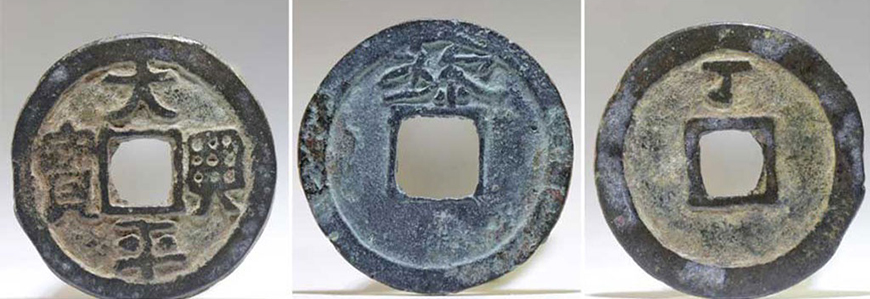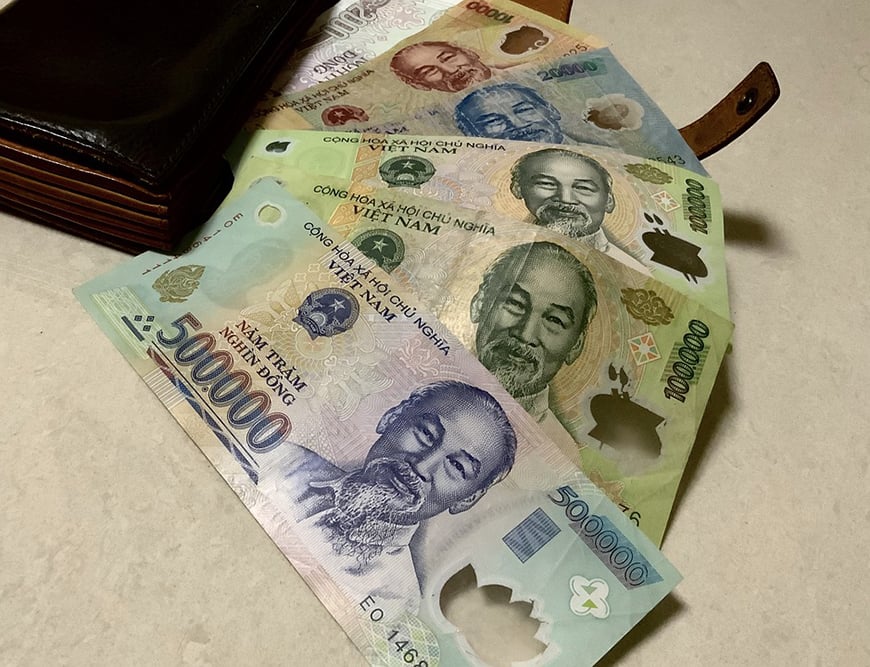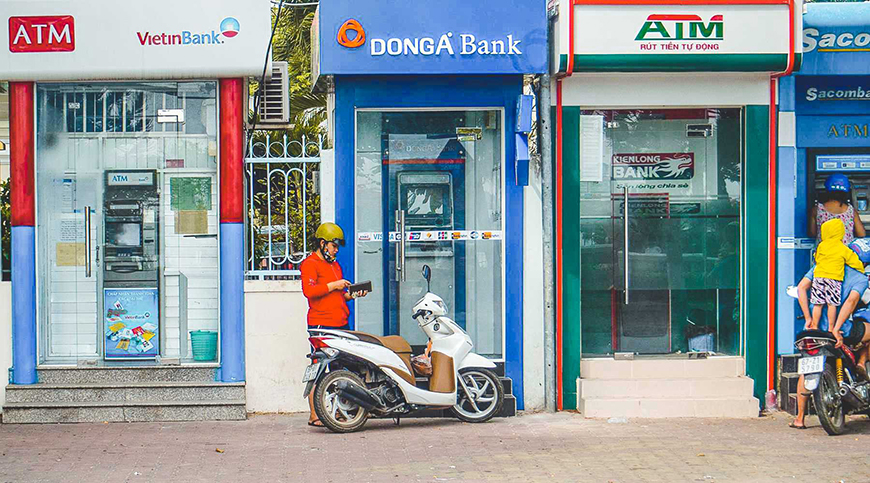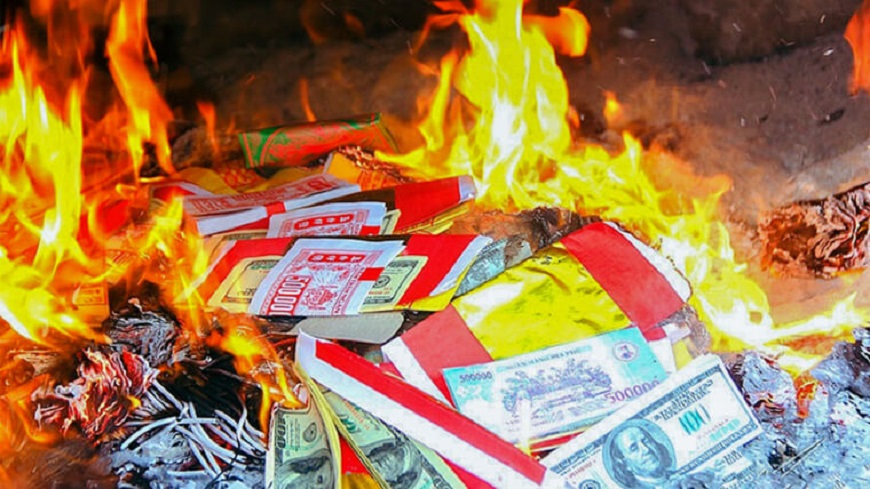During the preparation of a trip to Vietnam, we ask many questions, about the weather, the best route, the most beautiful sites or even what currency is used. How to pay, withdraw or change money in Vietnam? We answer all your questions here!
Introduction to the Vietnamese currency
In Vietnam, Southeast Asian country, the official currency unit is the Dong, symbolized by the underlined letter ₫ and abbreviated in VND (for Vietnam Dong) Its history is rich and complex. Nowadays, only the State Bank of Vietnam is legally entitled to issue Vietnamese banknotes and – according to current legislation – the Vietnamese dong is the only legal means of payment in Vietnam. But major tourist sites do not hesitate to display their prices in US dollars.
This article will guide you through the history of Vietnamese currency, help you understand the different banknotes in circulation, and give you tips on where and how to change money in Vietnam.

Thai Binh Hung Bao coin was the first coin of the independent feudal state of Vietnam - Photo : Bao Tang Lich Su
History of the Vietnamese currency
If today coins no longer exist, they tell stories about the men, dynasties and historical currents that crossed the Land of the Palanches. Thus, we recognize the currency that testifies to independence, another reflecting Confucian thought, or others, called diplomatic…
Pride of the Dinh dynasty, the Thai Binh Hung Bao coin was the first coin of the independent feudal state of Vietnam. The oldest is dated to the reign of King Dinh Bo Linh, in 968. It was made of bronze, of round shape and pierced by a central square hole, where the round shape symbolized the universe while the square hole represented the earth. On one side is the inscription Thái Binh hưng bảo (flourishing currency of the Thai Binh era), while the reverse carries the ideogram “Đinh” below the central hole.
Much later, the Vietnamese used to call their coins “đồng” (literally “copper”), in reference to the copper coins used during feudal times, then the Indochinese silver piastres took over during the French colonization.
It was not until 1946, shortly after the declaration of Vietnam’s independence in Hanoi, that the new currency replaced the piastre, with – for the record - a 1:1 exchange rate. On May 3, 1978, the dong became the official currency of Vietnam. The dong will undergo a thousand and one revaluations, not to mention the upheavals of history including the adoption of the Doi Moi renovation policy in 1986, which opened a market economy with a socialist orientation, but which was followed by a monetary crisis. Another will come in 1991, after the dissolution of the Soviet Union. These years saw the circulation of cotton banknotes of 100đ, 200đ, 500đ, 1 000đ, 2 000đ, 5 000đ, 10 000đ, 20 000đ, 50 000đ and 100 000đ. In 2003, cotton banknotes with values above 10,000 đ will be replaced by polymer banknotes of the same values.
Nowadays, only cotton and polymer banknotes exist with values ranging from 1 000đ to 500 000đ. The front of all the banknotes displays on the right the draw of President Ho Chi Minh while the emblem of Vietnam adorns the left, above the banknote’s value. To finish this overview of the history of the Vietnamese currency, note that coins have not been minted since 2013 – inflation requires – but their exchange is legal and possible (many decide to keep them to collect).
Note that Dong is one of the weakest currencies in the world, posting so much zero that it can confuse foreigners when they travel to Vietnam for the first time. Here’s how to recognize them…

The Vietnamese currency is the Vietnam Dong - Photo : Pixabay
Vietnamese banknotes
Currently, two types of banknotes are used in Vietnam, polymer and paper/cotton.
Cotton banknotes
These are low value notes: 1,000đ, 2,000đ and 5,000đ. With these tickets, it is possible to buy sweets, vegetables at the local markets, pay the parking fees for the motorcycle, or even make an offering in pagodas or temples.
Good to know: The 1,000 and 2,000 bills are very similar. You will be careful to distinguish them by their value number or graphics. The latter represents the logging in Tay Nguyen – for the 1,000 dong bill – and a textile weaving mill in Nam Dinh, for the 2,000 đ banknote.
Easily recognizable, the blue 5,000 đ banknote represents the hydroelectric plant erected on the Dong Nai River
Polymer banknotes
Their values are 10 000 đ, 20 000 đ, 50 000 đ, 100 000 đ, 200 000 đ and 500 000 đ.
The 10,000 dongs banknote is yellow in color and the visual on the back depicts Vietnam’s largest oil production site, located in Vung Tau.
The 20,000 dongs note is blue in color, its graphic represents the famous Japanese covered bridge of Hoi An, a UNESCO heritage site.
Between 10,000VND and 20,000VND, you will pay for entrance tickets to most tourist sites, drinks, street food… Dishes such as pho, bun cha tend to be more expensive, around 45,000 – 55,000VND
The 50,000 dongs banknote is pink and features a representation of the pavilions of the complex of the Hue’s Imperial Citadel, a UNESCO World Heritage site. It is with this ticket that you will pay for a simple but hearty meal in most popular restaurants. With, you will buy small souvenirs or tip your guide.
The 100,000-dongs green tones banknote pays tribute to the temple of literature, which was also Vietnam’s first university, today one of Hanoi’s iconic sites.
The 200,000-dongs note is orange-red and has a reverse print of the Dinh Huong Islet, in the famous Ha Long Bay.
To give you an idea, between 100,000 VND and 200,000 VND, you can get a dormitory bed or a single private double room for one night or rent a scooter a day.
The 500,000 Dongs note, the largest denomination, is dark blue and is adorned with the house of President Ho Chi Minh, Nghe An Province. This note is the key to a comfortable life, including lodging and cutlery.
Good to know: The 20,000 and 500,000 blue banknotes are very similar! This implies numerous and frequent errors (including for local people...). Take the time to carefully check the value, the size (the 500.000VND banknote is larger) and finally the visual on its the back.

You can easily find ATM in Vietnam - Photo : Internet
Where to change money in Vietnam
Vietnam is a cash country, and almost everything is paid for in cash, so it’s important to have a small bundle of banknotes on hand. You will most certainly, at some point or another, be confronted with the question of exchange and withdrawal of money.
There is no problem in Vietnam to change your currencies. Almost all banks in the country have a counter to change your euros or dollars. The ideal is to change a little money when arriving at the airport (50 euros will be enough) to cope with the first fees (sim card, taxis and other restaurants). Attention, if exchange services are available on arrival at the airport, rates are not as good as in town. Some large hotels in Hanoi and Saigon also offer a currency exchange service, with rather poor rates, it must be said.
Good to know: traditionally, jewelers offer the most interesting exchange rates. They accept all currencies and especially the exchange takes place very quickly. As surprising as it may seem, usage is very common, including for locals. Moreover, transactions are closely monitored by the authorities. There is in Ha Noi a street dedicated to currency exchange, it is the street Ha Trung, in the city center (on the side of the market of Ben Thanh, in Saigon). Check the amount received and if the tickets are in good condition! You are now a millionaire…
In any case, check the current exchange rate beforehand, either on the XE reference site or on the website of the Vietnamese bank Vietcombank.
A last tip: even if euros are increasingly accepted, but only in large cities and sometimes on major tourist sites, the king banknote remains the dollar, which you will change as indicated above.
How to pay and withdraw money in Vietnam
In Vietnam, you have two options to exchange and withdraw money:
At the bank, the most secure means of transaction transaction, which guarantees you to receive real new notes
In an ATM. Available (almost) everywhere, they allow easy and anytime withdrawal. These machines accept VISA or MASTER CARD, but the withdrawal is capped, which, in the long run, can lead to significant bank charges. Indeed, in addition to the fees that you may have to pay to your bank for a withdrawal of money abroad, you will also have to pay an additional fee to the bank that manages the ATM. These typically range from 30,000 VND to 50,000 VND, but some institutions may charge up to 100,000 VND for withdrawal.
Good to know: In general, banks open from Monday to Friday, from 8am to 5pm. In major cities, some open on Saturday morning.

Burning Ghost Money - Photo : Internet
Why do the Vietnamese burn money?
As you stroll along a sidewalk, you will be surprised to see people burning dollar bills with a face value of $100. In fact, they are just fictitious currencies. The Vietnamese believe that there is a world after death and that the souls of their loved ones should also spend money. So they burn counterfeit currency to « send » it to their loved ones. They burn iPhones, villas, cars, jewellery… We have even seen COVID-19 green certificates go up in smoke!
Avoid money scams in Vietnam
If Vietnam is a safe destination to travel, the S-shaped country is not free of dishonest individuals, as everywhere else in the world, unfortunately. To make sure your stay goes smoothly, follow our tips:
- 1.Keep your belongings in a safe place: Leave your passport and other travel documents in your hotel safe.
- 2.Avoid ostentatious wealth: Do not wear high value jewellery.
- 3. Avoid walking around with large amounts of money, or slip your bundles into a “banana” type of bag.
- 4. Never disclose your banking or personal information.
To conclude our journey in the world of the Vietnamese currency
Whether you are a tourist visiting the country or a long-time resident, it is important to understand how the Vietnamese currency works. And, we will not lie, the risks of error are indeed there. We hope this little guide will help you manage your money efficiently and avoid potential problems.